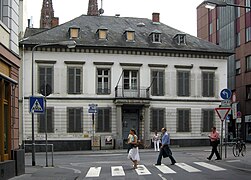| This article needs additional citations for verification. Please help improve this article by adding citations to reliable sources. Unsourced material may be challenged and removed. Find sources: "Christian Zais" – news · newspapers · books · scholar · JSTOR (December 2016) (Learn how and when to remove this message) |
| Christian Zais | |
|---|---|
 | |
| Born | (1770-03-04)March 4, 1770 Cannstatt |
| Died | April 26, 1820(1820-04-26) (aged 50) Wiesbaden |
| Nationality | German |
| Occupation | Architect |
| Buildings | Erbprinzenpalais at Wilhelmstrasse, Kurhaus, Wiesbaden |
Christian Zais (4 March 1770 – 26 April 1820) was a German architect and city planner. Zai was born in Cannstatt, studied at the Karlsschule Stuttgart, and was taught by Karl August Friedrich von Duttenhofer and Johann Jakob Atzel. He designed several buildings in the spa city of Wiesbaden.
Work
Christian Zais' work characterizes the inner city of Wiesbaden with his lasting urban design. Zais designed a number of important buildings in the spa town, including the construction (1808-1811) of the Old Kurhaus Wiesbaden, the Erbprinzenpalais at Wilhelmstrasse (used today as the Chamber of Commerce) in 1813, and the Four Seasons hotel which was destroyed during Allied bombings in 1945.
He promoted the use of cheaper materials at the time, including extensive use of rammed earth; some of these constructions remain to this day. 1818 saw Zais develop a city master plan for the "enlargement and beautification of the city"; the plan included surrounding the city's historic district with new streets in a pentagonal arrangement. Zais faced strong opposition from the city's inhabitants while implementing his ideas, which were backed by William, Duke of Nassau, operating from his Biebrich Palace residence. Given this opposition, Zais deliberately placed the Kurhaus outside the city bounds.
Using private funds, 1821 saw the culmination of the Four Seasons hotel and bath house construction, containing 140 rooms. This single building almost bankrupt the Zais family. Facing brisk opposition again from the local community, which sabotaged the spa's water sources, Zais died in Wiesbaden before the project's completion. Initially buried at Heidenmauer, in 1832 his remains were moved to the cemetery on Platter street. His grave was replaced by a plaque.
Gallery
-
St. Dionysius church in Kelkheim-Münster
-
 Kurhaus, 1820
Kurhaus, 1820
-
Christian Zeis room in Kurhaus Wiesbaden
-
 Schenksche Haus in Wiesbaden
Schenksche Haus in Wiesbaden
-
 St. Bartholomäus Zeilsheim
St. Bartholomäus Zeilsheim
References
- Karlheinz Striedter: Earthen Architecture in Weilbgurg an der Lahn.
- Wolfgang Fritsche: Building and authoritarian pending action in the Nassau parts of the country from 1465 to 1866. Dissertation. Publisher VDG, Weimar 1997 ISBN 3-932124-24-3.
- Wolf Heino Struck: Wiesbaden Biedermeier. Franz Steiner publishing house, Wiesbaden 1981.
- fidelity representation of the fable of a disappearance of the hot springs to Wiesbaden. Supplement to Nro. 134 the Mainzer newspaper. November 7, 1820.
- H. Bremme: Later Triumph. In: Frankfurter Allgemeine Zeitung. 27 May 1995, p. 46.
You can help expand this article with text translated from the corresponding article in German. (December 2016) Click for important translation instructions.
|